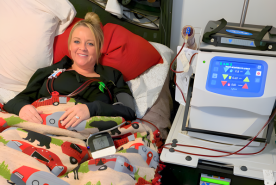Nephrectomy is the surgical removal of a kidney. It treats kidney cancer or removes a healthy kidney for transplant. Recovery and risks vary by procedure type.
What is a nephrectomy?
Nephrectomy (nephro = kidney, ectomy = removal) is the surgical removal of a kidney. The procedure is done to treat kidney cancer as well as other kidney diseases and injuries. Nephrectomy is also done to remove a healthy kidney from a donor (either living or deceased) for transplantation. Thousands of nephrectomies are performed every year in the U.S.
Types of nephrectomy
There are two types of nephrectomy for a diseased kidney: partial and radical. In partial nephrectomy, only the diseased or injured portion of the kidney is removed. Radical nephrectomy involves removing the entire kidney, along with a section of the tube leading to the bladder (ureter), the gland that sits atop the kidney (adrenal gland), and the fatty tissue surrounding the kidney. When both kidneys are removed at the same time, the procedure is called bilateral nephrectomy.
The procedure used to remove a healthy kidney from a donor for the purpose of transplantation is called donor nephrectomy.
Preparation for living donor nephrectomy
In order to be evaluated as a kidney donor you must be healthy and without diseases that may lead to kidney failure. These include diabetes and high blood pressure (hypertension). A potential donor is first tested for blood type compatibility with the potential recipient. After blood type compatibility is confirmed the health care team will perform several other tests. These tests are done to look for complications that could possibly cause the recipient’s body to reject the new kidney. Also, to identify any health problems in the potential donor that would make him or her unsuitable as a donor.
A couple of weeks before the scheduled transplant surgery, a kidney donor is given a complete physical examination and advised of any other instructions before the hospital admission. An evaluation from a social worker is done to make sure the donation is being done willingly and without pressure.
Before the operation, the surgical procedure will be explained to you in great detail, along with the possible risks and complications.
How is nephrectomy surgery done?
Laparoscopic Surgery
Some people who require a nephrectomy are suitable for laparoscopic surgery (also called minimally invasive surgery) to remove the kidney. Laparoscopic surgery involves the use of a laparoscope (wand-like camera) that is passed through a series of small incisions or “ports” in the abdominal wall. It is used to view the abdominal cavity and remove the kidney through a small incision. The procedure is done under general anesthesia (you are asleep and do not feel any pain). You will require a bladder catheter that is placed once you are asleep and is removed several hours after surgery.
Laparoscopy achieves the same things as traditional surgical techniques and can be used for both radical and partial surgery. It is also the preferred method for kidney transplant donor nephrectomy.
The advantages of laparoscopic surgery include:
- Shorter recovery time
- Shorter hospital stay
- Smaller incisions
- Fewer post-operative complications
Laparoscopic nephrectomy takes special skills to perform and is not available at all hospitals. Also, whether you can have laparoscopic surgery depends on your medical condition and overall health. Speak to your doctor about your options for laparoscopic nephrectomy.
Open Nephrectomy
Open nephrectomy is rarely required but is also done under general anesthesia. The surgeon makes a cut (incision) in the abdomen or in the side of the abdomen (flank area). A rib may need to be removed to perform the procedure. The ureter (the tube that carries urine from the kidney to the bladder) and the blood vessels are cut away from the kidney and the kidney is removed. The incision is then closed with stitches.
Immediately after surgery, your health care team will carefully watch your blood pressure, electrolytes and fluid balance. These body functions are controlled in part by the kidneys. You will most likely have a urinary catheter (tube to drain urine) in your bladder for a short time during your recovery.
You may have discomfort and numbness (caused by severed nerves) near the incision area. Pain relievers are given after the surgical procedure and during the recovery period as needed. Although deep breathing and coughing may be painful because the incision is close to the diaphragm, breathing exercises are important to prevent pneumonia.
You will probably remain in the hospital for 1 to 7 days, depending on the method of surgery used. You will be encouraged to return to light activities as soon as you feel up to it. Strenuous activity and heavy lifting should be avoided for 6 weeks following the procedure.
Your doctor will give you more detailed instructions about your post-operative activities, restrictions and diet.
All surgery has certain risks and complications. Possible complications of nephrectomy surgery include:
- Infection
- Bleeding (hemorrhage) requiring blood transfusion
- Post-operative pneumonia
- Rare allergic reactions to anesthesia
- Death
There is also the small risk of kidney failure in a patient with lowered function or disease in the remaining kidney.
Quick Fact: You are born with two kidneys, but you really only need one. A single healthy kidney can work as well as two kidneys, but if both kidneys are removed, dialysis or a transplant is necessary to maintain life.
The risks of donor nephrectomy for kidney transplantation are very small. This is likely because almost all living donors undergo careful pre-op testing and evaluation to make sure they are healthy enough for surgery. Most studies report death rates for donor nephrectomy in the range of 1 or 2 per 10,000 donor surgeries. About 1 or 2 per 100 patients may experience a post-operative wound infection or complication and about half of these patients may require re-operation for a complication.
The vast majority of kidney donors live long and healthy lives with one kidney.
Care of the remaining kidney
Tests will be done on a regular basis to check how well the remaining kidney is working. A urinalysis (urine test) and blood pressure check should be done every year, and kidney function tests (creatinine, glomerular filtration rate [GFR]) should be checked every few years (or more often if abnormal results are found). Regular urine tests for protein should be performed as well. The presence of protein in the urine may mean that the kidney has some damage.
People with one kidney should avoid sports that involve higher risks of heavy contact or collision. This includes, but is not limited to, boxing, field hockey, football, ice hockey, lacrosse, martial arts, rodeo, soccer and wrestling. This may also include extreme activities such as skydiving. Anyone with a single kidney who decides to participate in these sports should be extra careful and wear protective padding. He or she should understand that losing the remaining kidney is a very serious situation.
Where can I get more information?
Contact the National Kidney Foundation for information at 800.622.9010. If you have Internet access, you can find more information on our Transplant Education Programs page.
You can also get more information from the following organizations:
- National Cancer Institute, 1-800-4-CANCER (1-800-422-6237), or online at http://cancer.gov
- National Kidney and Urologic Disease Information Clearinghouse (NKUDIC), a service of the National Institute of Diabetes, Digestive and Kidney Diseases. Call 1-800-891-5390 or visit the website at www.niddk.nih.gov
Date Reviewed: July 2009
If you would like more information, please contact us.
© 2015 National Kidney Foundation. All rights reserved. This material does not constitute medical advice. It is intended for informational purposes only. Please consult a physician for specific treatment recommendations.








